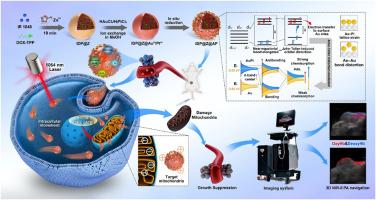用于肿瘤治疗的线粒体靶向和生物能量破坏的Jahn-Teller扭曲工程自推进纳米机器人
IF 18
1区 医学
Q1 ENGINEERING, BIOMEDICAL
引用次数: 0
摘要
线粒体代谢在肿瘤进展中起着关键作用,但有效的治疗靶向仍然受到有限的组织穿透和缺乏时空控制的限制。在此,我们提出了Jahn-Teller扭曲工程,自行推进的纳米机器人(IDP@Z@AP),它集成了催化氧生成,线粒体靶向药物递送和实时3D NIR-II光声(PA)成像,用于精确的肿瘤治疗。纳米机器人是通过在ZIF-8框架内共封装NIR-II光热剂(IR1048)和线粒体靶向化疗药物(DOX-TPP),然后原位锚定超小AuPt双金属纳米酶来制造的。pt诱导的Jahn-Teller扭曲调节了AuPt的电子结构,增强了葡萄糖氧化酶和过氧化氢酶样活性。在NIR-II激光照射下,光热增强级联催化驱动自主运动,催化肿瘤内O2生成,促进肿瘤深部浸润。体外研究显示有效的线粒体靶向,导致显著的线粒体膜去极化,细胞内ATP消耗,抑制细胞迁移和侵袭。在体内,3D NIR-II PA成像可以实现纳米机器人生物分布的无创可视化和肿瘤组织中催化氧生成的实时绘图。这个纳米机器人平台有效地调节肿瘤缺氧,增强化疗给药到线粒体,最终实现有效的肿瘤抑制。这项工作为亚细胞水平的癌症治疗提供了一种智能的、催化驱动的、线粒体靶向的实时治疗反馈策略。本文章由计算机程序翻译,如有差异,请以英文原文为准。

Jahn-Teller distortion-engineered self-propelled nanorobots for mitochondrial targeting and bioenergetic disruption in tumor therapy
Mitochondrial metabolism plays a pivotal role in tumor progression, yet effective therapeutic targeting remains constrained by limited tissue penetration and lack of spatiotemporal control. Herein, we present Jahn-Teller distortion-engineered, self-propelled nanorobots (IDP@Z@AP) that integrate catalytic oxygen generation, mitochondria-targeted drug delivery, and real-time 3D NIR-II photoacoustic (PA) imaging for precision tumor therapy. The nanorobots are fabricated by co-encapsulating a NIR-II photothermal agent (IR1048) and a mitochondria-targeting chemotherapeutic (DOX-TPP) within a ZIF-8 framework, followed by in situ anchoring of ultrasmall AuPt bimetallic nanozymes. Pt-induced Jahn-Teller distortion modulates the electronic structure of AuPt, enhancing glucose oxidase- and catalase-like activities. Under NIR-II laser irradiation, photothermal-enhanced cascade catalysis drives autonomous motion and catalyzes intratumoral O2 generation, facilitating deep tumor infiltration. In vitro studies reveal efficient mitochondrial targeting, resulting in significant mitochondrial membrane depolarization, intracellular ATP depletion, and suppressed cell migration and invasion. In vivo, 3D NIR-II PA imaging enables noninvasive visualization of nanorobot biodistribution and real-time mapping of catalytic oxygen generation within tumor tissues. This nanorobotic platform effectively modulates tumor hypoxia and enhances chemotherapeutic delivery to mitochondria, ultimately achieving potent tumor suppression. The work offers a smart, catalytically driven, mitochondria-targeted strategy with real-time therapeutic feedback for subcellular-level cancer therapy.
求助全文
通过发布文献求助,成功后即可免费获取论文全文。
去求助
来源期刊

Bioactive Materials
Biochemistry, Genetics and Molecular Biology-Biotechnology
CiteScore
28.00
自引率
6.30%
发文量
436
审稿时长
20 days
期刊介绍:
Bioactive Materials is a peer-reviewed research publication that focuses on advancements in bioactive materials. The journal accepts research papers, reviews, and rapid communications in the field of next-generation biomaterials that interact with cells, tissues, and organs in various living organisms.
The primary goal of Bioactive Materials is to promote the science and engineering of biomaterials that exhibit adaptiveness to the biological environment. These materials are specifically designed to stimulate or direct appropriate cell and tissue responses or regulate interactions with microorganisms.
The journal covers a wide range of bioactive materials, including those that are engineered or designed in terms of their physical form (e.g. particulate, fiber), topology (e.g. porosity, surface roughness), or dimensions (ranging from macro to nano-scales). Contributions are sought from the following categories of bioactive materials:
Bioactive metals and alloys
Bioactive inorganics: ceramics, glasses, and carbon-based materials
Bioactive polymers and gels
Bioactive materials derived from natural sources
Bioactive composites
These materials find applications in human and veterinary medicine, such as implants, tissue engineering scaffolds, cell/drug/gene carriers, as well as imaging and sensing devices.
 求助内容:
求助内容: 应助结果提醒方式:
应助结果提醒方式:


